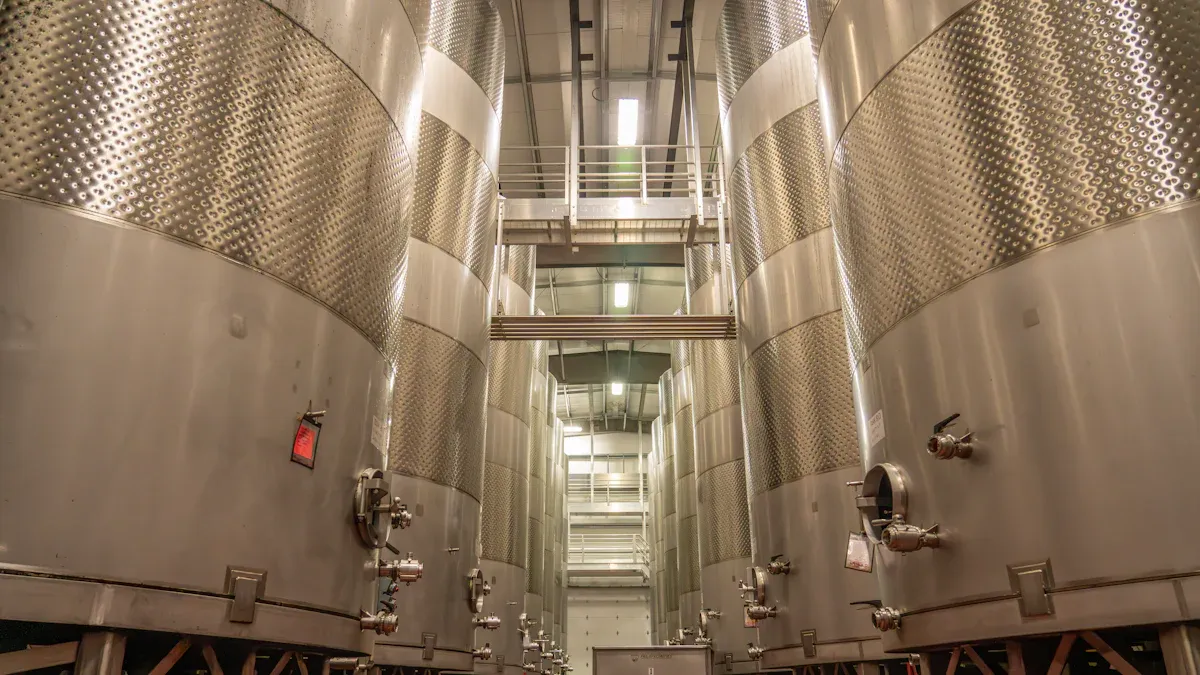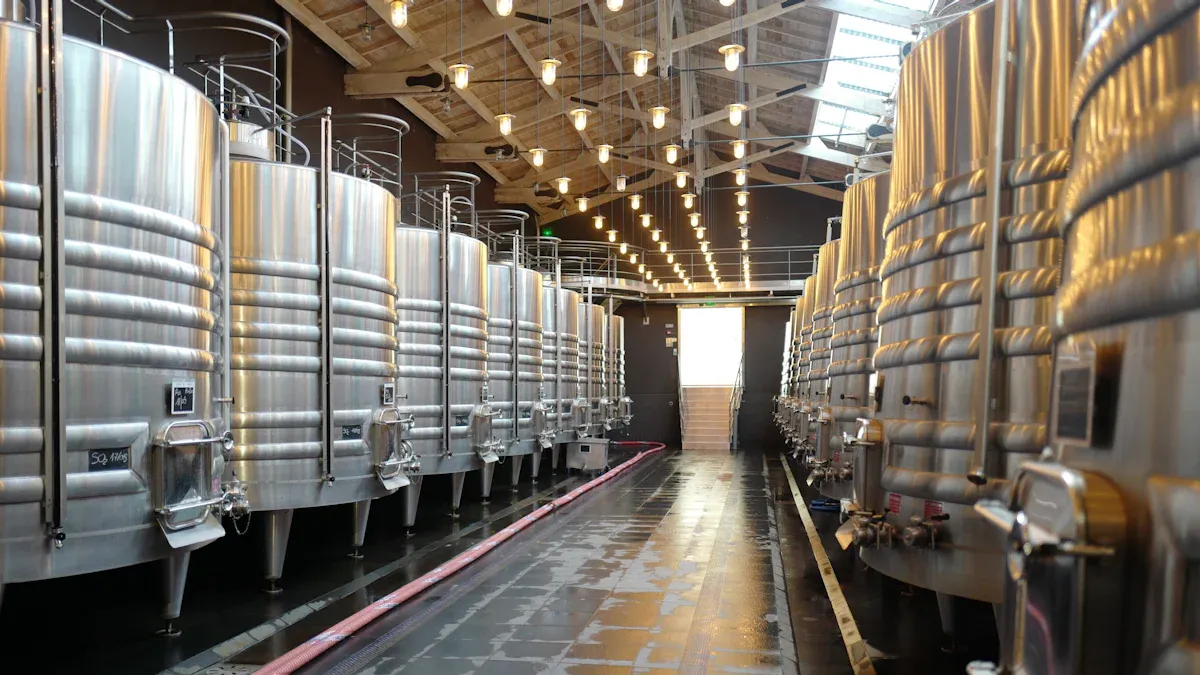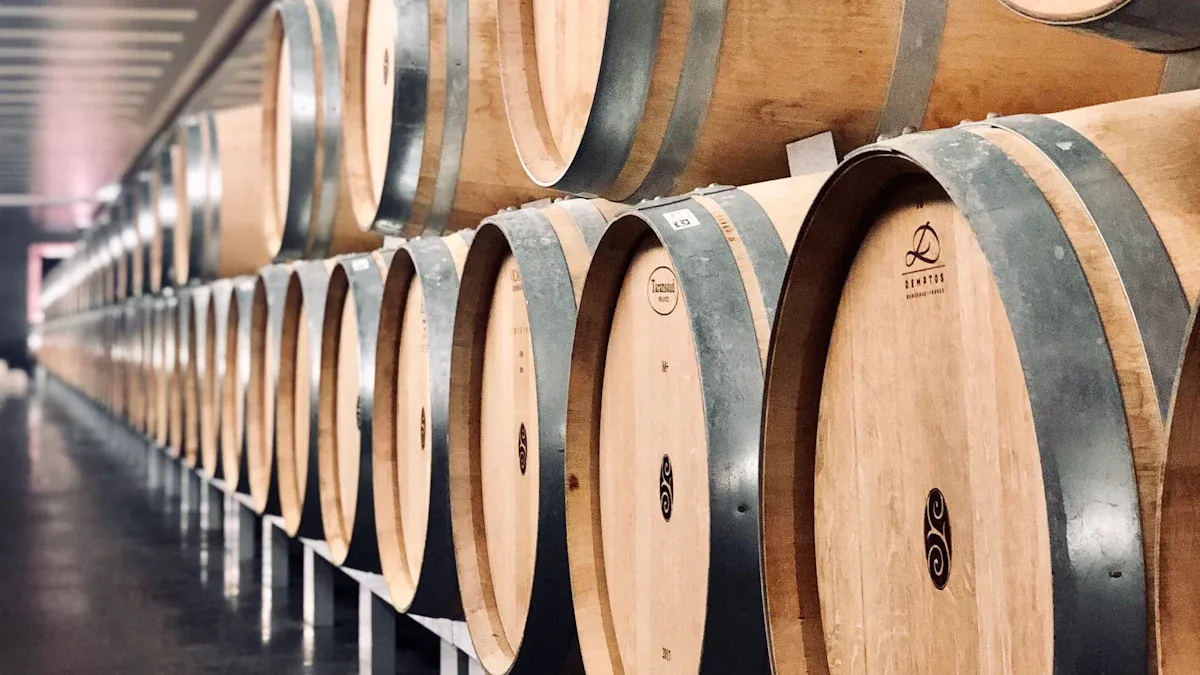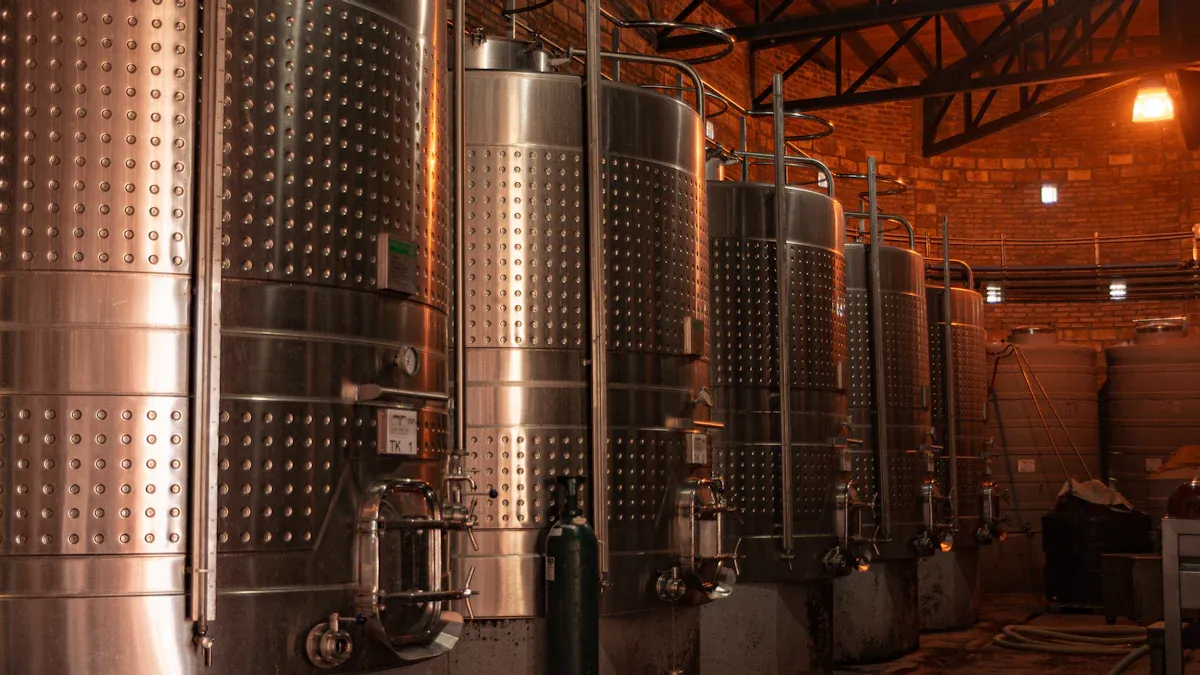
So, can you ferment wine in stainless steel? The answer is a definite yes. This modern technique is how winemakers create the crisp, fruit-forward wines popular with many drinkers today. Stainless steel fermentation is a deliberate choice. It allows winemakers to preserve the grape’s natural flavors without adding outside tastes. This guide explores the process and the resulting clean character of these popular wines.
In a time of struggle for the U.S. wine market, Sauvignon Blanc is a notable bright spot.
The popularity of this style is clear. Recent data shows significant growth for wines known for their freshness:
- Central Coast Sauvignon Blanc saw an 18% volume increase.
- White wine sales are projected to grow faster than red wines through 2029.
So, Can You Ferment Wine in Stainless Steel?
Yes, you can ferment wine in stainless steel. This method has become a standard in modern winemaking. It gives winemakers precise control over the final product. The result is often a wine that tastes clean, bright, and true to its grape variety.
The Modern Winemaking Standard
Stainless steel tanks are a common sight in wineries around the world. Their use signals a shift toward creating wines with vibrant, pure fruit flavors. Winemakers value these tanks for their reliability and consistency. This equipment helps produce high-quality wines year after year. The question “can you ferment wine in stainless steel?” is answered by its widespread adoption in the industry.
Why It’s a Deliberate Choice
Winemakers choose stainless steel for specific stylistic goals. The fermentation process is carefully managed to shape the wine’s final character. Key objectives include:
- Achieving clean, fruit-forward profiles in a neutral environment.
- Ensuring purity and consistency from one batch to the next.
- Using precise temperature control to guide flavor development.
This careful control allows winemakers to craft specific styles of wines. It is a deliberate method for a predictable and high-quality outcome.
Preserving the Grape’s True Character
The main benefit of steel is its inert nature. It does not add any flavor or aroma to the wine. This focus on preserving freshness and fruit expression is why many ask, “can you ferment wine in stainless steel?” The non-porous surface of the tank is also crucial. It prevents unwanted microbes from growing, which could spoil the wine. This ensures the final taste comes only from the grapes and the fermentation itself, reflecting the vineyard’s unique terroir.
The Stainless Steel Fermentation Process

The stainless steel fermentation process gives winemakers exceptional control over the final wine. This control comes from three key factors: the environment, temperature, and overall efficiency. These elements work together to produce a clean and expressive wine.
An Oxygen-Free Environment
Stainless steel creates an airtight seal. This design provides little to no oxygen exposure during fermentation. The absence of oxygen is crucial. It prevents oxidation, a chemical reaction that can make fruit flavors taste dull. This protected environment ensures the wine remains fresh and vibrant. Without oxygen, other reactions that soften tannins or add flavors like vanilla do not occur. The wine’s character comes purely from the grape.
The Role of Temperature Control
Temperature management is vital for preserving delicate aromas. High temperatures can destroy the floral and fruity notes in a wine. Stainless steel tanks allow for precise temperature control, which helps protect these fragile compounds. Winemakers can cool the tank to guide the fermentation and lock in flavor.
Winemaker’s Tip 📝 Aromatic white grapes often require a very cool fermentation to retain their signature scents.
- Ideal Range: 50–60 °F (10–16 °C)
- Benefit: This slow, cool process prevents delicate floral and fruit aromas from evaporating.
High-quality stainless steel fermentation tanks, produced by expert manufacturers like Shandong Chenma Machinery, are engineered to meet strict ISO and CE quality standards. These features enable the exact temperature management needed to achieve specific aromatic profiles.
Improving Winemaking Efficiency
Beyond flavor, stainless steel fermentation vessels offer practical advantages. Their smooth, non-porous surfaces are easy to clean and sanitize. This efficiency saves wineries significant time and money compared to cleaning traditional oak barrels. The clean environment also reduces the risk of spoilage from unwanted microbes.
| Vessel Type | Average Cleaning Time | Estimated Cleaning Cost (at $20/hour) |
|---|---|---|
| Oak Barrel | 5 minutes | $1.66 |
| Stainless Steel | 1 minute | $0.33 |
This ease of maintenance helps winemakers produce consistent, high-quality wine with every batch. The stainless steel fermentation method is both a stylistic choice and a smart operational one.
The Resulting Wine Flavors
Fermenting wine in stainless steel creates a distinct and recognizable style. The process is designed to highlight the grape itself, not the vessel. This results in wines that are vibrant, fresh, and expressive of their origin. The final flavor profile is a direct outcome of this controlled, neutral environment.
Bright Fruit and Crisp Acidity
Stainless steel fermentation is famous for producing bright fruit flavors and sharp acidity. This happens because the method preserves specific chemical compounds from the grape and fermentation process.
- Esters: Fermentation forms these compounds. They create fresh, fruity aromas like pear in Pinot Grigio or green apple in Chardonnay.
- Terpenes: These compounds exist in the grapes. They provide floral and citrus notes, such as the lime and floral scents in Riesling.
- Thiols: These sulfur-based compounds deliver tropical and citrus aromas. They are responsible for the grapefruit and passionfruit notes in Sauvignon Blanc.
Acidity is the other key component. It makes the fruit flavors taste more lively and zesty. The high acidity in a steel-fermented Chardonnay, for example, enhances its green apple and lemon notes. This crispness makes the wine feel refreshing and clean on the palate.
A Lighter, Cleaner Profile
Wines fermented in stainless steel have a lighter body and a cleaner finish. The airtight environment prevents oxygen from interacting with the wine. This reductive process preserves the youthful, primary fruit characteristics. The resulting wine’s flavor profile is pure and direct.
The goal of steel fermentation is transparency. The winemaker wants you to taste the grape and the vineyard, not the vessel.
This method avoids the creamy textures and secondary flavors of vanilla or spice that come from oak. Instead, the focus remains entirely on the fruit, creating wines that are sharp, linear, and easy to drink.
Why Steel Imparts No Taste
Stainless steel does not impact wine flavor because it is an inert material. Food-grade stainless steel, like grades 304 and 316, has a special property. It forms a passive, self-healing layer of chromium oxide on its surface. This microscopic layer acts as a shield. It protects the metal from the acids in wine, such as tartaric and citric acid.
This non-reactive surface ensures that no metallic taste or unwanted chemicals leach into the liquid. The steel itself does not rust or degrade, preserving the purity of the flavors. Grade 316 steel contains molybdenum, which offers even greater resistance, making it ideal for all types of wines. Ultimately, the tank is a neutral container, allowing the true character of the grape to shine through without alteration.
Oak vs Stainless Steel: A Comparison

The choice between oak vs stainless steel as fermentation and aging vessels is one of the most important decisions a winemaker makes. This choice directly shapes a wine’s final character. One vessel preserves the grape’s natural taste, while the other adds new layers of complexity. Understanding the oak vs stainless steel debate helps you know what to expect in your glass.
Imparted Flavors vs. Preserved Flavors
The primary difference between these fermentation vessels is how they affect the flavors of the wine. Stainless steel is inert, meaning it adds no taste. It acts as a neutral container that preserves the grape’s primary fruit aromas. Oak barrels, on the other hand, actively impart flavors into the wine.
The traditional role of oak is to contribute a rich bouquet of secondary flavors. As wine rests in the barrel, it extracts various compounds from the wood. These compounds can include:
- Vanillin: Adds a vanilla or sweet cream aroma.
- Lactones: Provide notes of coconut, dill, or toasted wood.
- Eugenol: Gives spicy notes like clove or allspice.
- Furfural: Contributes hints of caramel, butterscotch, and dried fruit.
This interaction fundamentally changes the wine’s profile. A comparison of oak vs stainless steel clearly shows two different stylistic goals. Steel aims for purity, while oak aims for complexity.
| Fermentation Method | Effect on Chardonnay’s Primary Fruit Aromas |
|---|---|
| Stainless Steel | Preserves freshness and highlights crisp notes of green apple, lemon, and pear. |
| Oak Barrel | Fresh fruit aromas evolve into richer notes of baked apple, dried pineapple, and Meyer lemon. |
Texture: Creamy and Round vs. Crisp and Sharp
The vessel choice also has a major impact on the wine’s texture, or mouthfeel. Stainless steel tanks create wines that feel crisp, sharp, and linear on the palate. The lack of oxygen exposure keeps the acidity high and the body light.
Oak fermentation and aging produce a much different result. Wines aged in oak barrels often feel creamier, rounder, and fuller. This texture change comes from two sources. First, the slow introduction of oxygen softens the wine. Second, many oak-aged wines undergo malolactic fermentation (MLF). This process converts sharp malic acid (like in a green apple) into softer lactic acid (like in milk).
While MLF can occur in any container, its creamy effects are often amplified by the complementary flavors from oak barrels. This combination creates the rich, velvety texture many people love in oaked wines.
The Impact of Micro-Oxygenation
Oak is porous, while stainless steel is airtight. This structural difference is critical. The tiny pores in oak wood allow very small amounts of oxygen to enter the wine over time. This process, known as micro-oxygenation, has a profound effect on red wines.
Stainless steel tanks, being completely sealed, prevent any oxygen from interacting with the wine. This reductive environment is perfect for preserving the zesty, fresh character of aromatic white wines. However, it does not provide the same structural development for tannins that oak fermentation and aging vessels do. This is why bold red wines designed for aging are rarely made in steel. The choice of fermentation and aging vessels is key to how they will develop.
Best Grapes for Stainless Steel Fermentation
Certain grape varieties are perfect for stainless steel fermentation. Winemakers choose this method to highlight the grape’s natural character. The goal is to produce vibrant, fresh, and aromatic wines that taste true to their origin.
Sauvignon Blanc, Riesling, and Pinot Grigio
Aromatic white grapes are ideal candidates for stainless steel. Winemakers typically ferment Sauvignon Blanc in steel tanks to preserve its crisp, zesty character. This method is also preferred for Riesling and Pinot Grigio. It helps maintain their fresh, vibrant qualities and delicate floral notes. The steel vessel ensures the final wine expresses the pure fruit flavors of the grape without any outside influence.
Crisp Rosé and Sparkling Wines
Stainless steel is essential for creating modern crisp rosé and sparkling wines. Winemakers in regions like Provence use specific techniques to achieve a pale pink color and delicate aromas.
- Direct Press: Grapes are pressed immediately after harvest. This method creates the palest rosés with fresh, citrusy notes.
- Maceration: Grapes soak with their skins for a few hours. This process gives the wine more color and structure.
After pressing, the juice moves to stainless steel tanks for a controlled, cool fermentation. This step is crucial for preserving the clean, refreshing profile that makes these wines so popular.
Gamay and Unoaked Pinot Noir
While less common, some red grapes also benefit from stainless steel. This method is perfect for producing light-bodied, fruit-forward red wines like Gamay and unoaked Pinot Noir. The absence of oak allows the bright cherry and raspberry notes of these grapes to shine. The resulting wines are juicy and smooth, designed for early enjoyment rather than long-term aging.
Grapes Better Suited for Oak Fermentation
While stainless steel excels at preserving freshness, some grapes need the influence of wood to reach their full potential. Oak fermentation and aging vessels are essential for developing complexity, structure, and age-worthiness in certain wines.
Cabernet Sauvignon, Merlot, and Syrah
Full-bodied red grapes like Cabernet Sauvignon, Merlot, and Syrah have a high tannin structure. Oak fermentation helps soften these firm tannins. The process creates a smoother, more balanced wine. These dense grape varieties can absorb oak flavors without losing their unique character.
Winemakers often choose French oak for a gentler influence. The wood imparts subtle spice and structure, complementing the grape’s natural profile.
The interaction with oak fermentation barrels allows these wines to develop complex layers of dark chocolate and spice over time. This evolution enhances the overall drinking experience.
Oaked Chardonnay and Viognier
Chardonnay and Viognier are white grapes that transform beautifully with oak. The oak fermentation process often works with a secondary conversion called malolactic fermentation. This process creates creamy, buttery textures in the wine. These buttery notes combine with compounds from the oak, such as vanillin. The result is a rich profile with a spectrum of flavors.
- Vanilla
- Stone fruits (peach, apricot)
- Ripe apple
- Toasted almonds
This combination produces the classic “oaked Chardonnay” style, known for its full body and complex, layered character.
Wines Designed for Aging
Oak is crucial for wines built to last. During aging, chemical changes occur that improve a wine’s structure and longevity. The wood releases phenolic compounds, which add complexity. The porous nature of oak also allows for micro-oxygenation. This slow exposure to air helps stabilize color and soften the wine’s texture. These chemical reactions transform the primary fruit aromas into a mature bouquet, creating wines that can evolve for years.
Identifying Steel-Fermented Wines
Finding a wine fermented in stainless steel is simple with a little knowledge. Consumers can look for specific clues on the bottle, recognize key regions, or ask for help. These methods make it easy to select a wine with a crisp, fruit-forward profile.
Reading the Wine Label
The wine label often provides the clearest information. Winemakers who use stainless steel to achieve a specific style usually want to tell consumers about it. People should look for specific terms on the front or back label.
- “un-oaked”: This term clearly states the wine did not spend time in a wood barrel.
- “inox”: This is an abbreviation for the French word for stainless steel, inoxydable. It signals fermentation in a steel tank.
Other descriptive words like crisp, fresh, or vibrant also suggest a steel-fermented style.
Common Regions and Styles
Certain wine regions are famous for their unoaked styles. Knowing these regions helps shoppers find the right bottle. Sancerre, a region in France, is well-known for producing Sauvignon Blancs without oak influence. This method preserves the grape’s signature minerality and citrus notes. Other classic examples include most Chablis from Burgundy and many Rieslings from Germany’s Mosel valley. These areas prioritize purity and terroir expression in their white wines.
Asking for Recommendations
When in doubt, asking an expert is a great strategy. A knowledgeable staff member at a wine shop or a sommelier at a restaurant can offer excellent guidance.
How to Ask 🗣️ A person can simply say, “I’m looking for a crisp, unoaked white wine,” or “Can you recommend a red that hasn’t been aged in oak?”
This direct approach helps the expert point to the perfect bottle that matches the desired fresh and clean taste profile.
Beyond Steel and Oak: Other Vessels
Winemakers have more choices than just steel and oak. Other fermentation and aging vessels offer unique benefits, creating different textures and flavors. Exploring these alternative fermentation vessels helps wine lovers understand the full spectrum of winemaking styles. Tasting wines from different vessels reveals the impact each material has on the final product.
The Role of Concrete Tanks
Concrete fermentation tanks are a popular middle ground between steel and oak. Concrete is porous, much like an oak barrel. This structure allows for micro-oxygenation, which helps soften a wine’s texture. However, unlike oak, concrete is a neutral material and imparts no flavor. This preserves the grape’s pure fruit character.
| Vessel Type | Oxygen Permeability |
|---|---|
| Stainless Steel | Airtight (no oxygen) |
| Oak | Porous (allows oxygen) |
| Concrete | Medium (similar to oak) |
Many modern concrete tanks are shaped like eggs. This shape creates a natural current, or vortex, during fermentation. The vortex keeps the lees (spent yeast cells) suspended, which builds a richer texture and a rounder mouthfeel. This type of vessel can add a distinct mineral quality to the wine.
Traditional Clay and Amphora
Clay pots, or amphorae, are the most ancient fermentation vessels. Modern winemakers are returning to this traditional method. Clay is also porous, allowing the wine to breathe. This process softens tannins and adds complexity without adding any woody flavors. The result is a wine with pure fruit expression and a unique texture.
Glass and Other Niche Vessels
Glass containers like carboys and demijohns are another option. They are most common for small-batch experiments or home winemaking. The main advantage of glass is its transparency. Winemakers can watch the fermentation process unfold. Glass is also completely inert and easy to keep odor-free.
However, glass has its downsides:
- It is heavy and very fragile.
- The narrow necks can make cleaning difficult.
These fermentation and aging vessels are perfect for hobbyists or professionals testing new recipes. Ultimately, tasting wines from different vessels is the best way to appreciate how each material shapes the final wine. The choice of fermentation vessel is a key decision in the winemaking journey.
Stainless steel fermentation is a deliberate choice winemakers make. This method produces vibrant wines that reflect the grape’s pure character and the vineyard’s terroir. Understanding this process helps people appreciate the crisp, refreshing style of many modern wines and answers the question, “can you ferment wine in stainless steel?”
Next time you shop for wine, confidently pick a bottle marked ‘unoaked’ or ‘stainless steel’ to experience the pure taste of the grape. 🍇
FAQ
Can you age wine in stainless steel?
Yes, winemakers can age wine in steel. This process preserves the wine’s fresh fruit flavors. It does not add oak notes or allow oxygen exposure. The wine remains crisp and vibrant, maintaining its youthful character.
Does stainless steel make wine taste metallic?
No, stainless steel does not give wine a metallic taste. High-quality, food-grade steel is an inert material. It has a protective layer that prevents any flavor transfer. The wine’s original taste stays pure and unaltered.
Why is temperature control so important?
Temperature control protects a wine’s delicate aromas. High heat can destroy floral and fruit notes. Winemakers use cool temperatures to lock in these fresh scents. This process creates a more aromatic and expressive final wine.
Are all stainless steel tanks the same?
No, quality varies significantly. Expert manufacturers produce tanks that meet high safety and quality standards like ISO and CE. These superior tanks ensure precise winemaking control. They help create consistent, high-quality wines with every batch.



